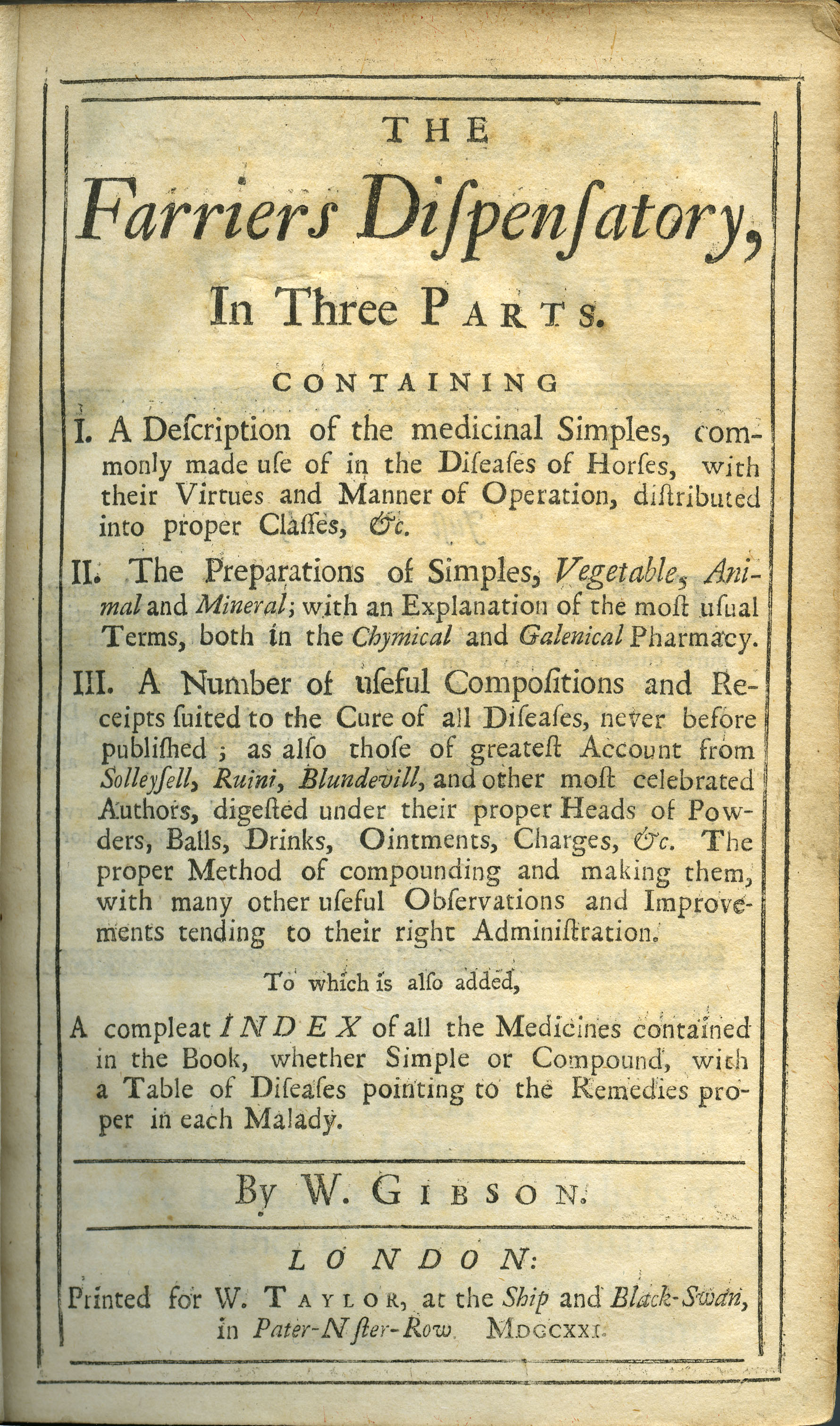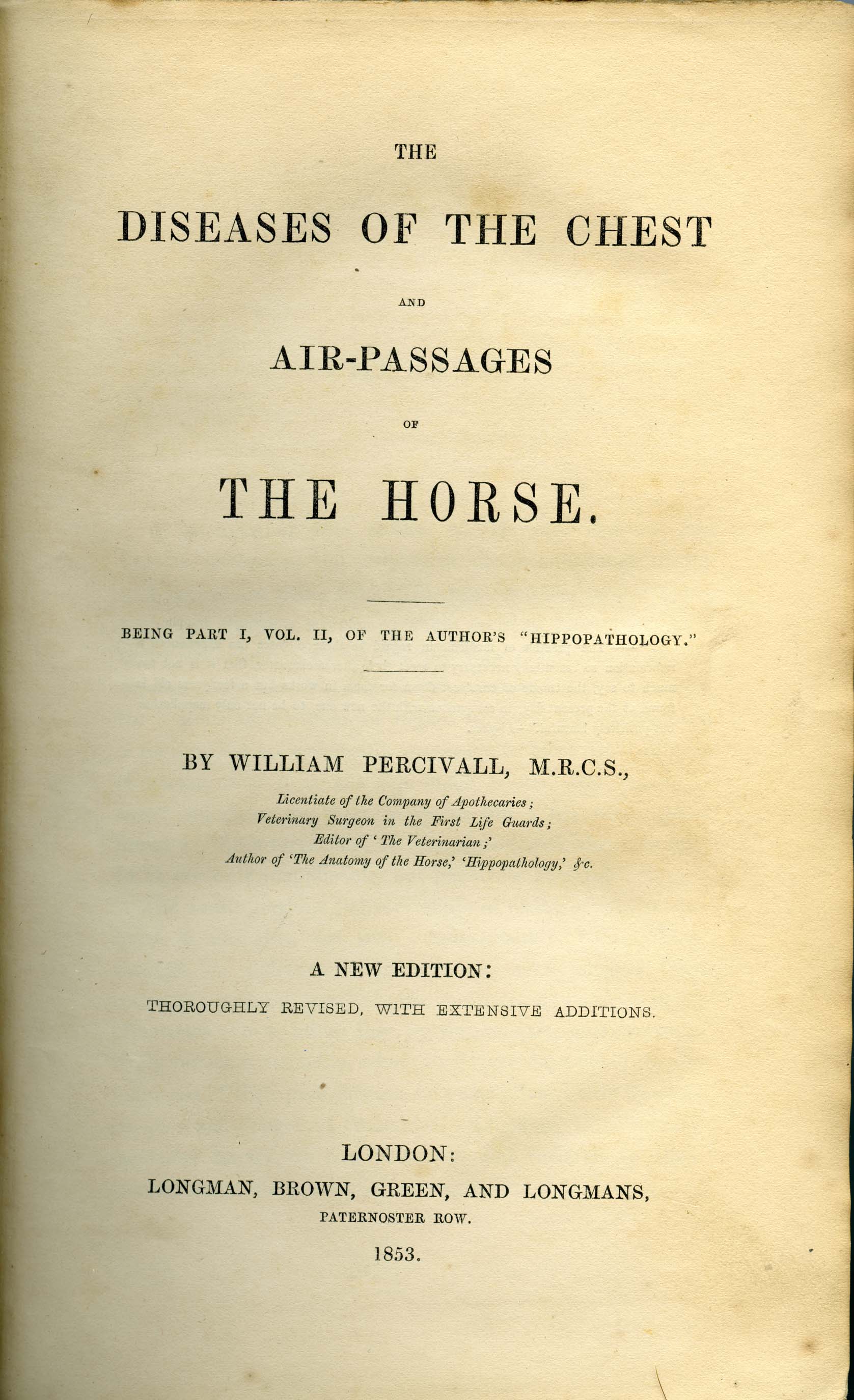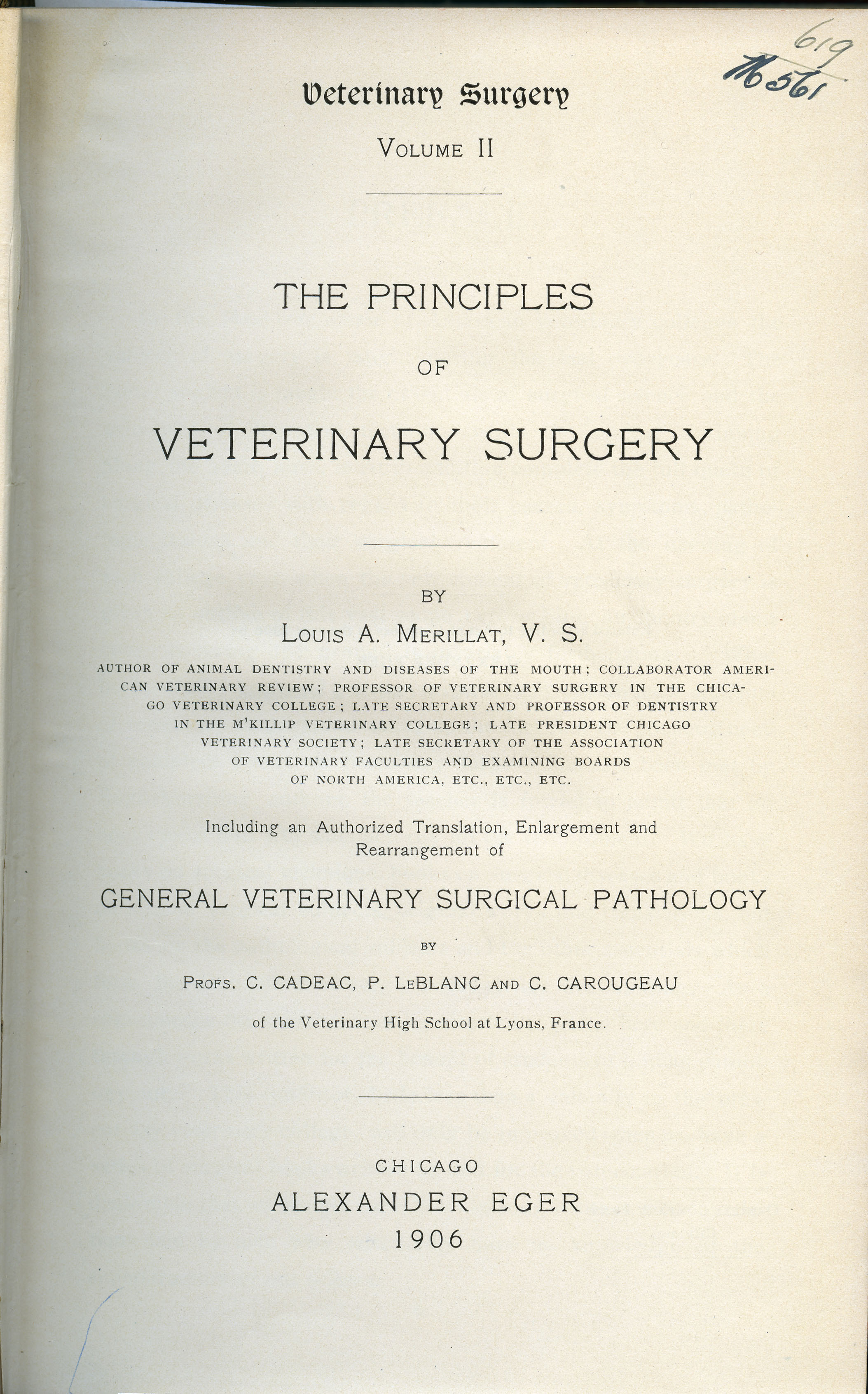Military Veterinarians
Horses, because of their importance to humans over several centuries and in many cultures, have figured prominently as the focus of veterinary practice and as subjects of veterinary literature output. Considering the various roles that horses and mules fulfilled in military conflicts up until the close of World War II, some of the most accomplished authors writing about the care of horses were veterinarians who came from a military background or practiced in the military environment. Around 1795, shortly after the time of the founding of the London Veterinary School, the military became an advantageous career option for veterinarians because they were commissioned officers paid at a higher rate of pay than cavalry farriers. Military veterinarians with works represented in the Rosen collection include William Gibson, William Percivall, George Fleming, Colonel Chris Forrest, H.E. Cross, Major-General Sir Frederick Smith, and Louis Merillat.
William Gibson (168?-1750) was a military surgeon who conducted a horse practice in London for 30 years. He is best known for authoring A New Treatise on the Diseases of Horses, 1751. This title although not in the Rosen collection is in print as volume 2 at the University of Saskatchewan in the Veterinary Medicine Rare collection and in two editions in electronic format. Dr. Rosen collected Gibson’s The Farriers’ Dispensatory, 1721 that is a supplement to A Treatise. The Dispensatory includes formulations of simple medications and forms of administration such as powders, balls, ointments and charges for treating horses. Gibson wrote The Dispensatory, because as he notes in the Preface, he did not like the secretive nature that farriers employed towards their work, nor their lack of treatment options. His do-it-yourself instructions for compounding and administration of remedies were aimed at the animal owner. He, too, was accused of plagiarism, although in the Preface, he does acknowledge the earlier writings of de Solleysel, Ruini, Blundeville, and other equine practitioners and trainers.
William Percivall (1792-1854) was an Army veterinary officer with several contributions to his profession related in the Biographies section. Percivall wrote The Anatomy of the Horse in 1832 and a 4-volume Hippopathology published between 1834 and 1852. He published Lectures on the Form and Action of Horses in 1850, and Diseases of the Chest and Air-passages of the Horse in 1853.
“The advancement of veterinary knowledge by clinical observation was a feature ever present with Percivall” (Smith, 1976a, p. 170).
George Fleming (1833-1901) was Principal Veterinary Surgeon to the British Army in 1883 and a Veterinary Inspector to the British War Office. Fleming would have seen firsthand that large numbers of horses were kept in close quarters leaving them vulnerable to infectious diseases, such as glanders. “By the close of the 18th century, the British army had decided that they should invest in the services of medically educated veterinary professionals, rather than continuing to rely on the traditional cavalry farriers (Swabe, 1999, p. 92). At a conference on animal vaccination in 1880, Fleming urged that Chairs of Comparative Pathology be established at all British medical schools, following the example of veterinary schools on the Continent. He felt that "... knowledge of animal disease would be much more valuable to [human] doctors than their existing curriculum’s comparative anatomy and zoology were” (Dunlop and Williams, 1996, p. 380). Fleming was also an editor of the influential journal The Veterinarian from 1876 to 1894.
Col. Chris Forrest (no dates) wrote The Complete American Farrier, and Horse Doctor, date of publication estimated to be 1880. The work’s subtitle Showing Plainly How to Breed, Buy, Sell, Cure, Shoe and Keep that Most Valuable Animal, the Horse. With Copious Notes from the Best English and American Authorities… clearly indicates the topic. Forrest’s contributions to the veterinary literature of horse care fall into Smithcors’s category of “humane methods of treatment” (Smithcors, 1957, p. 255). In the Preface to The Complete American Farrier, and Horse Doctor, Forrest (1923, p. 9) spells out his goals for writing the book, “The doctrines and teaching of our great American horsemen, second to none in the world, require to be condensed and popularized for general use, and it is to this task, in part that I have set myself, with genuine love of my subject, intending to write for American readers only". He makes the case for humane treatment of horses, stating in the Preface, “The world has outgrown a good deal that was counted for wisdoms a few generations ago, and some of the old “horsebooks” are but stupid collections of “old grannyisms”, or directions for the commission of cruel barbarities in the way of cuttings, burnings, cauterizations, physicking, nicking, etc."(Forrest, 1923, p. 10).
“The world has outgrown a good deal that was counted for wisdoms a few generations ago, and some of the old “horsebooks” are but stupid collections of “old grannyisms”, or directions for the commission of cruel barbarities in the way of cuttings, burnings, cauterizations, physicking, nicking, etc."(Forrest, 1923, p. 10).
H. E. (Henry Eustace) Cross (no dates) The Camel and its Diseases: Being Notes for Veterinary Surgeons and Commandants of the Camel Corps, 1917.
Major-General Sir Frederick Smith (1857-1929) was a trained veterinarian and, by vocation, an historian. He published clinical works on veterinary hygiene, anthrax, veterinary physiology and surgery, as well as on veterinary history, war and the Royal Veterinary Corps. Smith was a graduate of London’s Royal Veterinary College (RVC) in 1876 and served in the British army in India. In 1882 he established the quarterly Journal of the Royal Army Veterinary Corps in India with J.H. Steel. His works in the Rosen collection include A Manual of Veterinary Hygiene, 1905, The Early History of Veterinary Literature and its British Development, 4 volumes, 1976, and A History of the Royal Army Veterinary Corps, 1796-1919, 1927.
Louis A. Merillat (1868-1956) was the son of a horseman from Ohio and a graduate of the Ontario Veterinary College in Canada. Over the course of a long career he was a successful practitioner, educator, army veterinarian, author, editor, and contributor to the advancement of the profession. After graduation, Merillat established equine practices in New York and Chicago during the heyday of the urban horse. He taught at McKillip Veterinary College (1893-1900; 1913-19) and also at the Chicago Veterinary College (1900-13). As a practitioner he developed new surgical operations and anaesthetic techniques. His expertise attracted the attention of some of the most prominent stables of the city, including several with show teams of draft horses (Smith, 2015, p. 2). During WWI he was a veterinarian for the 41st Division and later became chief veterinarian for the First Army. According to the Tribune, "... he supervised the care and treatment of tens of thousands of horses crippled in battle..." (Smith, 2015, p. 2). After the war, he returned to France and spent six months studying at the Alfort National Veterinary College. By the time he returned home, Merillat remarked that “... the automobile had wiped out..." his practice, so he turned to writing (Smith, 2015, p. 2). He authored a major book on equine surgery entitled Principles of Veterinary Surgery. He was editor-in-chief of JAVMA from 1939 to 1952. He also authored a two-volume book on military veterinary history. Always having been active in organized veterinary medicine, he served as president of the AVMA in 1924-25. Near the end of his life, at the 60th anniversary of his Ontario Veterinary College graduation in 1948, he was toasted as the “outstanding veterinarian in America.” Merillat died on Feb 25, 1956, and was buried at Arlington National Cemetery with full military honours.



Veterinary Researchers
Agricultural Writers
Surgeon-Veterinarians

